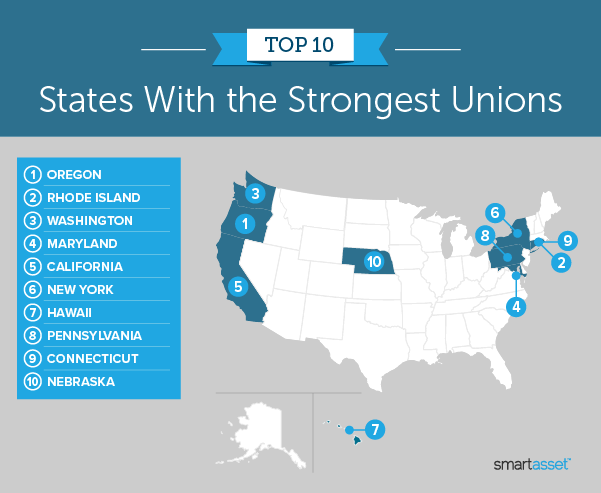The U.S. Bureau of Labor Statistics says that roughly one out of 10 workers in 2020 were union members (10.8%). Membership has gone up 0.5% since 2019, but has decreased by more than half since 1983, when approximately one out of five workers were union members (20.1%). Historically, organized labor has played an influential role in the U.S. workforce, establishing and defending employee rights since the first union was founded by Philadelphia shoemakers in 1794. Keeping this in mind, SmartAsset crunched the numbers to see where unions are strongest nationwide.
To do this, we considered seven metrics: percentage of workers who are union members, the four-year change in union membership, average annual wage for all workers, average annual wage for middle school teachers, salary ratio of teachers to all occupations, average annual wage for firefighters and the salary ratio for firefighters to all occupations. We looked specifically at teachers and firefighters because these two professions generally have the highest unionization rates, according to the BLS. For details on our data sources and how we put all the information together to create our final rankings, read the Data and Methodology section below.
You can read the 2020 edition of SmartAsset’s study on the states with the strongest unions here.
Key Findings
- Workers in states with strong union membership earn almost 14% more nationwide. The average annual wage for all workers across the study is $53,567. In the top 10 states where unions are the strongest, this average is $60,904. By contrast, in the 10 states where unions are the least strong, this figure is $47,264.
- Membership is up slightly. Nationwide, union membership is slightly up over the past four years, climbing 2.85%. An average of 10.2% workers are union members across all 49 states we analyzed (Vermont is excluded because of insufficient data). The highest union membership is in Hawaii (23.63%), while the lowest is in South Carolina (2.90%).

1. Oregon
Oregon ranks in the top 20 for every one of the metrics we measured. The state has the seventh-highest percentage of both workers in unions (16.20%) and four-year change in union membership (an increase of 20.34%). Oregon also places ninth for the salary ratio of firefighters to all occupations – firefighters earn 111.95% of the average salary of all workers.
2. Rhode Island
Rhode Island places in the top 10 for three different metrics. It has the third-highest percentage of workers who are union members (17.79%), fifth-highest salary ratio of teachers to all occupations (126.25%) and eighth-highest average annual wage of middle school teachers ($76,050).
3. Washington
The average annual wage for all workers in Washington State is $66,870, the third-highest average salary out of all the states in this study. Washington also places third in terms of salary for firefighters ($77,700). Approximately 17.38% of all workers are in unions, the fifth-highest rate for this metric in this study.
4. Maryland
Middle school teachers in Maryland earn an average annual salary of $77,770, the sixth-highest annual earnings on this list. The average annual wage for all workers is $63,610, seventh-highest out of all the states studied. Firefighters, meanwhile, earn $64,490 each year on average, the eighth-highest salary for this metric across the study.
5. California
Firefighters in California earn the second-highest average annual salary ($86,860), which is 132.13% of the average annual salary for all workers (also the second-highest rate for this metric). The average annual wage for all workers in the Golden State is on the higher end too, ranking fourth at $65,740.
6. New York
The Empire State has a 22.01% rate of union membership, the second-highest in the nation. New York places first in both of the metrics we used involving teachers – middle school teachers earn $89,150 on average, which is 131.39% of the average annual salary of all workers.
7. Hawaii
Hawaii has the highest rate of union membership in the country, with 23.63%. Firefighters in the state earn $68,590 on average each year, which is 117.87% of the average salary for all workers. Those figures rank fifth and fourth in this study, respectively.
8. Pennsylvania
The salaries of commonly unionized professions are high compared with the average salaries across industries in Pennsylvania. Teachers earn 129.14% of the median average salary for all workers, while firefighters earn at a rate of 113.07% of the median average salary. Those figures rank fourth- and eighth-highest in the study, respectively. The average annual wage is $53,950 across all workers, 18th-highest overall.
9. Connecticut
The average annual wage for all workers in Connecticut is $65,450 – the fifth-highest in this study. Middle school teachers earn $81,140 and firefighters earn $67,630, ranking fourth- and sixth-highest, respectively. Union membership sits at 17.10%, sixth-highest out of all the states we studied.
10. Nebraska
Nebraska wraps up the top 10 with a union membership increase of 32.31% in the four-year period from 2016 to 2020, the second-highest jump for this metric in the study. Overall, union membership makes up 9.58% of the state workforce, ranking near the middle of the study at 23rd-highest. Additionally, median salary places 31st-highest, at $50,260.

Data and Methodology
To find the states with the strongest unions, SmartAsset considered data from 49 states (Vermont had insufficient data) across the following seven metrics:
- Percentage of workers who are union members. Data comes from UnionStats.com and is for 2020.
- Four-year change in union membership. Data comes from UnionStats.com and is for 2016 and 2020.
- Average annual wage for all occupations. Data comes from the Bureau of Labor Statistics (BLS) and is for 2020.
- Average annual wage for middle school teachers. Data comes from the BLS and is for 2020. According to the BLS, among occupational groups, one of the highest unionization rates in 2020 was in education, training and library occupations. Middle school teacher is a prominent occupation within that industry. Workers in this job tend to make middle-range salaries for all occupations within the industry.
- Salary ratio for teachers to all occupations. Data comes from the BLS and is for 2020.
- Average annual wage for firefighters. Data comes from the BLS and is for 2020. According to the BLS, among occupational groups, one of the highest unionization rates in 2020 was in protective service occupations. Firefighter is a prominent occupation within that industry. Workers in this job tend to make middle-range salaries for all occupations within the industry.
- Salary ratio for firefighters to all occupations. Data comes from the BLS and is for 2020.
First we ranked each state in each metric. We then found the average ranking for each state, giving a double weight to the two metrics regarding union membership – the percentage of workers in unions and four-year change in union membership – and a half weight to the four metrics regarding average annual wages and salary ratios for teachers and firefighters. We then used the average rankings to create our final rankings. The state with the highest average ranking received a score of 100, and the state with the lowest average ranking received a score of 0.
Protect Your Paycheck With Smart Financial Planning
- Seek expert advice. Whether you’re in a union or not, a financial advisor can help you keep your financial life on track. SmartAsset’s free tool matches you with financial advisors in your area in just five minutes. If you’re ready to be matched with local advisors that will help you achieve your financial goals, get started now.
- It’s never too early or too late to save. Even if you’re fresh out of college, now is always a good time to start saving for retirement. If you have access to a workplace retirement plan like a 401(k), make sure you are taking advantage of it. If not, consider opening an individual retirement account (IRA).
Questions about our study? Contact press@smartasset.com.
Photo credit: ©iStock.com/NanoStockk
